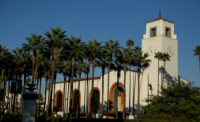|
In automobile-dominated Los Angeles, it seems entirely fitting that two of the city’s most celebrated buildings of recent years are a gas station and a drive-through hamburger restaurant. The United Oil Gasoline Station (2009) at the corner of Slauson and La Brea features a swooping steel canopy and a curved concrete ramp meant to resemble a freeway entrance. The red-and-yellow In-N-Out Burger (1998) in Westwood takes its design cues from the company’s boomerang logo and pays homage to Southern California Googie architecture.
Both projects were designed by Stephen Kanner, a third-generation Los Angeles architect who died of pancreatic cancer on July 2. He was 54.
Kanner was principal of Kanner Architects, founded in 1946 by Kanner’s grandfather, I. Herman Kanner; his son, Charles, took over in 1974. Stephen Kanner joined the firm in 1982 after working at Skidmore, Owings and Merrill in Los Angeles and Cambridge Seven Associates in Massachusetts.
Kanner’s passion for architecture extended beyond the office. He was co-founder and president of the Architecture and Design Museum of Los Angeles, which for 10 years occupied a series of temporary spaces before finding a permanent home in April [RECORD, May 2010, page 38]. In 2005, Kanner served as president of AIA Los Angeles. He also served six years on the Westwood Design Review Board, and he renovated about a dozen historic buildings in Westwood.
Click on the slide show icon to see additional photos.
Kanner considered his work a cheerful reinterpretation of Southern California modernism. His projects—houses, commercial and public buildings, and apartments—were often playful and exuberant. For his 2002 Metro Hollywood Transit Village, he accented a street-facing façade with Mondrian-like primary colors. For his own house in Pacific Palisades, dubbed 511 House, Kanner combined modernism with nautical touches [RECORD, May 2002].
“He really saw the joy in architecture,” says colleague Winston Chappell, who is also married to Kanner’s sister, Catherine. “And he believed that good design could improve people’s lives in unexpected ways.”
Los Angeles, Kanner told Curbed LA, is “a great place to practice architecture because, compared to other cities, there’s a higher percentage of clients with an open mind.” In 1992, when Kanner was working with his father, a client asked the architects to design an apartment building in the city’s Koreatown neighborhood, and he wanted something distinctive. The result: the firm’s award-winning Harvard Apartments. “What we gave him,” Stephen Kanner told the Los Angeles Times in 1993, “was a ham-and-Swiss-cheese sandwich of white-bread modernism with a filling of L.A. funk.”
Architect Richard Meier got to know Kanner during the 12 years Meier spent working on the Getty Center. At the time, their offices were both in Westwood, and they would often meet for lunch. In a statement, Meier said that “Steve’s work, like Steve, had an originality and a free-spirit quality that reflected the openness and diversity of Los Angeles.”



